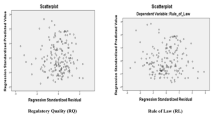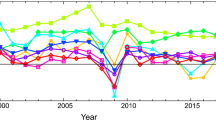Abstract
We consider the weighting scheme that results in a best-case scenario in the construction of the world governance indicators (WGIs), a proxy of institutional quality. To perform that, we use an approach that relies on consistent tests for stochastic dominance efficiency of a given index with respect to all possible indices constructed from a set of individual components. The test statistics and the estimators are computed using mixed integer programming methods. The results show that the equally weighted (fixed weights) composite WGI index is not the best-case scenario and that governance indicators at different years should be weighted differently. Furthermore, we revisit the institutions hypothesis in the empirical growth literature, where institutional quality is the main determinant of long-term development. We find that not only do institutions matter for economic development but also geography and macroeconomic policies do affect economic development directly.
Similar content being viewed by others
Notes
Space restrictions preclude us to present the best-case scenario WGIs for each year, but we present the best-case scenario for each governance indicator. The results for the best-case scenarios for each year are available upon request from the author.
Similar applications employed by Pinar et al. (2013) to construct the best-case scenario of Human Development Index and Agliardi et al. (2012) to construct the riskiest sovereign risk index for the emerging countries. The current study differs from the above mentioned ones in two ways. First, both Pinar et al. (2013) and Agliardi et al. (2012) examine the absolute levels of human development and sovereign risk, respectively. However, in the current paper, we examine the relative levels of governance indicators. In this case, we derive the least volatile governance indices and therefore these indices will be less subject to measurement error. Second, the current study examines the effect of the use of the proposed indices in the relevant literature as institutional quality proxies and provides further insights on how measurement could be an important issue.
As each governance indicator is bounded between \(-\)2.5 and +2.5, higher measured governance levels for more countries suggest a distribution that is negatively skewed and therefore having lower variability across countries and over time.
Each aggregate governance indicator is highly correlated with the other aggregate governance indicators at a given year. Moreover, each governance indicator outcomes at a given year is highly correlated with the following year’s outcomes of that indicator. The correlation coefficients, both the simple and the Spearman-rank ones, are very high (above 0.9) and very significant.
We have defined above \(\varvec{\lambda }\) and \(\varvec{\tau }\) to be different weighting vectors that are associated with different indices. In the discussion that follows, we use \(\varvec{\lambda }\) and \(\varvec{\tau }\) interchangeably with the index that they represent.
Test statistics are obtained for different governance levels considering all possible weight combinations which require mixed integer and linear programming for the first- and second-order SDE test statistics. See Sect. 4 of the ST for the mathematical formulation details.
We thank an anonymous referee for suggesting us to test for the first-stage best-case scenarios.
The next sections summarize the findings of the three studies when the best-case scenario governance indices are used as institutional proxies. However, detailed findings of the three studies are available upon request from the author.
To assess the robustness of the findings in the next sections, we also test whether the equally weighted governance indices are the best-case scenario indices or not for the full sample size which consists around 200 observations. We find that the equally weighted indices are not the best-case scenarios for all governance indices when the full sample size is used. Even though weights assigned to each year in the case of full sample size differ from the ones that are found with different sample sizes, the findings that are presented in the next sections do not change significantly when the best-case scenario governance indices for the full sample size are used as institutional proxies. Especially, the different results with the revisited papers still hold when the best-case scenario indices for the full sample size are used. Full sample size best-case scenario governance indices and detailed findings of three studies with those indices are available upon request from the author.
BG (2009) cited Rodrik et al. (2004) paper that the available language instruments for large sample do not pass over-identification test, whereas in the previous section, we find that the language instruments are valid for some of the best-case institutional quality indices. However, we continue with BG specification.
References
Aidt T, Dutta J, Sena V (2008) Governance regimes, corruption and growth: theory and evidence. J Comp Econ 36:195–220
Acemoglu D, Johnson S, Robinson JA (2001) The colonial origins of comparative development: an empirical investigation. Am Econ Rev 91:1369–1401
Agliardi E, Agliardi R, Pinar M, Stengos T, Topaloglou N (2012) A new country risk index for emerging markets: a stochastic dominance approach. J Emp Financ 19:741–761
Anderson G (1996) Nonparametric tests of stochastic dominance in income distributions. Econometrica 64:1183–1193
Arndt C, Oman C (2006) Uses and abuses of governance indicators. Organization for Economic Cooperation and Development (OECD) Development Center Study, Paris
Barrett GF, Donald SG (2003) Consistent test for stochastic dominance. Econometrica 71:71–104
Bawa VS, Bodurtha JN Jr, Rao MR, Suri HL (1985) On determination of stochastic dominance optimal sets. J Financ 40:417–431
Beach C, Davidson R (1983) Distribution-free statistical inference with Lorenz curves and income shares. Rev Econ Stud 50:723–735
Beck T, Laeven L (2006) Institution building and growth in transition economies. J Econ Growth 11:157–186
Bloom DE, Sachs JD (1998) Geography, demography, and economic growth in Africa. Brookings Pap Econ Act 2:207–295
Bosker M, Garretsen H (2009) Economic development and geography of institutions. J Econ Geogr 9: 295–328
Brunnschweiler CN (2008) Cursing the blessings? Natural resource abundance, institutions, and economic growth. World Dev 36:399–419
Bulte EH, Damania R, Deacon RT (2005) Resource intensity, institutions and development. World Dev 33:1029–1044
Davidson R, Duclos J-Y (2000) Statistical inference for stochastic dominance and for the measurement of poverty and inequality. Econometrica 68:1435–1464
Diamond J (1997) Guns, germs, and steel: the fates of human societies. W.W. Norton, New York
Dollar D, Kraay A (2003) Institutions, trade and growth. J Monet Econ 50:133–162
Durlauf SN, Kourtellos A, Tan CM (2008) Are any growth theories robust? Econ J 118:329–346
Engerman SL, Sokoloff KL (1997) Factor endowments, institutions, and differential paths of growth among new world economies: a view from economic historians of the United States. In: Haber S (ed) How Latin America fell behind. Stanford University Press, Stanford, pp 260–304
Easterly W, Levine R (2003) Tropics, germs, and crops: how endowments influence economic development. J Monet Econ 50:3–39
Easterly W (2007) Inequality does cause underdevelopment: insights from a new instrument. J Dev Econ 84:755–776
Fishburn PC (1974) Convex stochastic dominance with continuous distribution functions. J Econ Theory 7:143–158
Frankel JA, Romer D (1999) Does trade cause growth? Am Econ Rev 89:379–399
Gallup JL, Mellinger AD, Sachs JD (1998) Geography and economic development. NBER Working Paper No. 6849
Glaeser EL, La Porta R, Lopez-de-Silanes F, Shleifer A (2004) Do institutions cause growth? J Econ Growth 9:271–303
Hall RE, Jones C (1999) Why do some countries produce so much more output per worker than others? Q J Econ 114:83–116
Harms P, Lutz M (2006) Aid, governance and private foreign investment: some puzzling findings for the 1990s. Econ J 116:773–790
Horvath L, Kokoszka P, Zitikis R (2006) Testing for stochastic dominance using the weighted McFadden-type statistic. J Econom 133:191–205
Kaufmann D, Kraay A, Zoido-Lobaton P (1999) Aggregating governance indicators. World bank Policy Research Working Paper 2195
Kaufmann D, Kraay A, Zoido-Lobaton P (2002) Governance matters II—updated indicators for 2000/01. World Bank Policy Research Working Paper 2772
Kaufmann D, Kraay A, Mastruzzi M (2004) Governance matters III: governance indicators for 1996, 1998, 2000, and 2000. World Bank Econ Rev 18:253–287
Kaufmann D, Kraay A, Mastruzzi M (2005) Governance matters IV: governance indicators for 1996–2004. World Bank Policy Research Working Paper 3630
Kaufmann D, Kraay A, Mastruzzi M (2006) Governance matters V: aggregate and individual governance indicators for 1996–2005. World Bank Policy Research Working Paper 4012
Kaufmann D, Kraay A, Mastruzzi M (2007a) Governance matters VI: aggregate and individual governance indicators for 1996–2006. World Bank Policy Research Working Paper 4280
Kaufmann D, Kraay A, Mastruzzi M (2007b) The worldwide governance indicators project: answering the critics. World Bank Policy Research Working Paper 4149
Kaufmann D, Kraay A, Mastruzzi M (2008) Governance matters VII: aggregate and individual governance indicators for 1996–2007. World Bank Policy Research Working Paper 4654
Knack S (2006) Measuring corruption in Eastern Europe and Central Asia: a critique of the cross-country indicators. World Bank Policy Research Working Paper 3968
Kopa M, Chovanec P (2008) A second-order stochastic dominance portfolio efficiency measure. Kybernetika 44:243–258
Kopa M, Post T (2011) A general test for portfolio efficiency. SSRN Working Paper. SSRN. http://ssrn.com/abstract=1824174
Kuosmanen T (2004) Efficient diversification according to stochastic dominance criteria. Manage Sci 50:1390–1406
Kurtz MJ, Schrank A (2007) Growth and governance: models, measures and mechanisms. J Polit 69: 538–554
Linton O, Whang, Y-J (2012) Testing for the stochastic dominance efficiency of a given portfolio. CEMMAP Working Paper No. CWP27/12
Mankiw NG, Romer D, Weil DN (1992) A contribution to the empirics of economic growth. Q J Econ 107:407–437
Manly BFJ (1994) Multivariate statistical methods: a primer. Chapman & Hall, London
Nardo M, Saisana M, Saltelli A, Tarantola S, Hoffman A, Giovanni E (2005) Handbook on constructing composite indicators: methodology and user guide. OECD Statistics Working Paper 2005/3
Neumayer E (2002) Is good governance rewarded? A cross-national analysis of debt forgiveness. World Dev 30:913–930
North DC (1990) Institutions, institutional change and economic performance. Cambridge University Press, New York
Pinar M, Stengos T, Topaloglou N (2013) Measuring human development: a stochastic dominance approach. J Econ Growth 18:69–108
Post T (2003) Empirical tests for stochastic dominance efficiency. J Financ 58:1905–1932
Post T, Versijp P (2007) Multivariate tests for stochastic dominance efficiency of a give portfolio. J Financ Quant Anal 42:489–516
Rodrik D, Subramanian A, Trebbi F (2004) Institutions rule: the primacy of institutions over geography and integration in economic development. J Econ Growth 9:131–165
Sachs JD (2003) Institutions matter, but not for everything. Financ Dev 40:38–41
Sachs JD, Warner AM (1997) Fundamental sources of long-run growth. Am Econ Rev 87:184–188
Scaillet O, Topaloglou N (2010) Testing for stochastic dominance efficiency. J Bus Econ Stat 28:169–180
Wong W-K, Phoon K, Lean H (2008) Stochastic dominance analysis of Asian hedge funds. Pacific-Basin Financ J 16:204–223
Acknowledgments
This research is part of author’s PhD thesis at the Department of Economics of the University of Guelph. The author wishes to thank his PhD supervisor Thanasis Stengos, and committee members, Michael Hoy, Ege Yazgan, Alex Maynard, Ilias Tsiakas, and James Amegashie for their helpful suggestions and comments on improving the paper. The author is also grateful to anonymous referees for their constructive comments and suggestions.
Author information
Authors and Affiliations
Corresponding author
Rights and permissions
About this article
Cite this article
Pinar, M. Measuring world governance: revisiting the institutions hypothesis. Empir Econ 48, 747–778 (2015). https://doi.org/10.1007/s00181-013-0796-0
Received:
Accepted:
Published:
Issue Date:
DOI: https://doi.org/10.1007/s00181-013-0796-0
Keywords
- World governance indicators
- Institutions
- Geography
- Openness
- Nonparametric stochastic dominance
- Mixed integer programming




